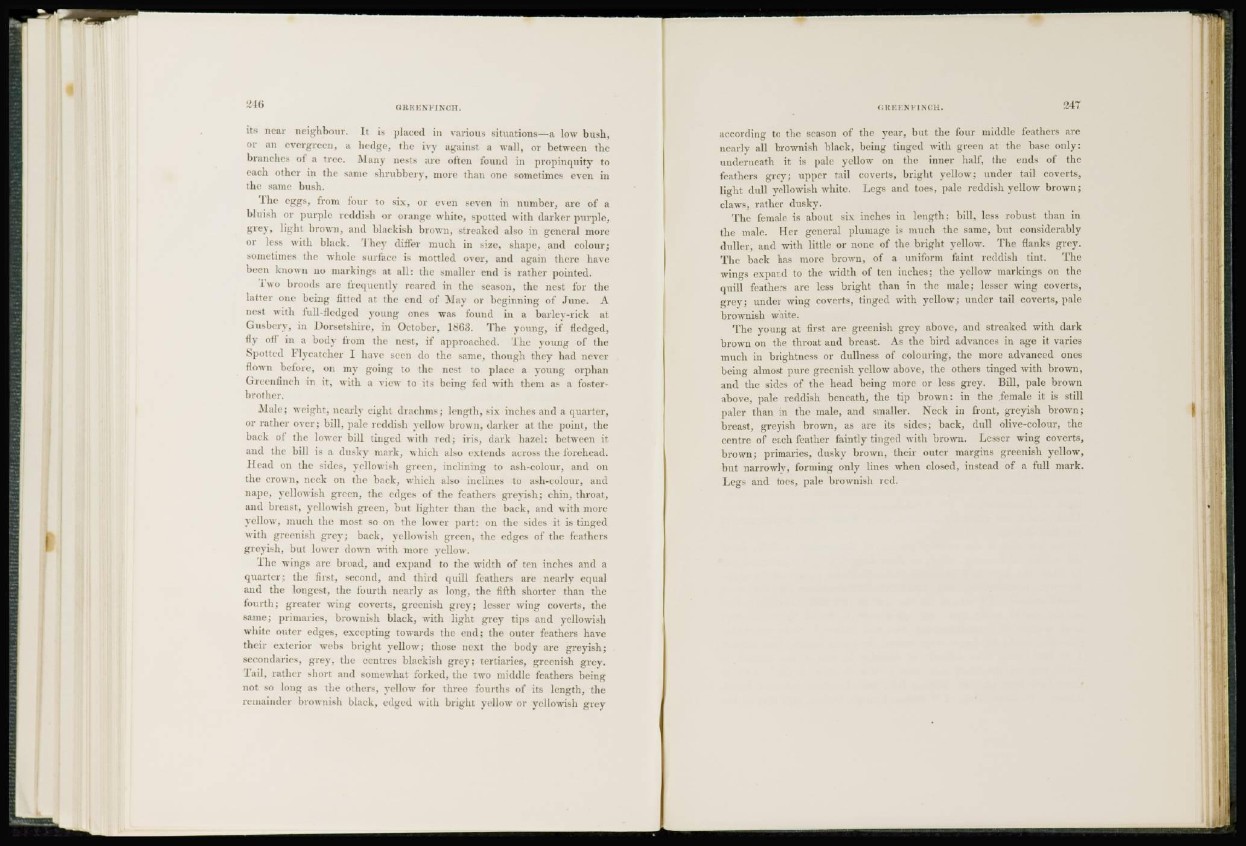
246 0 RE E \ PINCH.
its near neighbour. It is placed in various situations—a low hush,
or an evergreen, a hedge, the ivy against a wall, or between the
branches of a tree. Many nests are often found in propinquity to
each other in the same shrubbery, more than one sometimes even in
the same bush.
The eggs, from four to six, or even seven in number, are of a
bluish or purple reddish or orange white, spotted with darker purple,
grey, light brown, and blackish brown, streaked also in general more
or less with black. They differ much in size, shape, and colour;
some time- the whole sui face is moit led over, and again there have
been known no markings at all: the smaller end is rather pointed.
Two broods are frequently reared in the season, the nest for the
latter one being fitted at the end of May or beginning of June. A
nest with full-fledged young ones was found in a barlcy-rick at
Gusbery, in Dorsetshire, in October. 18f>3. The young, if fledged,
fly off in a body from the nest, if approached. The young of the
Spotted Flycatcher I have seen do the same, though they had never
flown before, on my going to the nest io place a young orphan
Greenfinch in it, with a view to its being fed with them as a fosterbrother.
Male; weight, nearly eight drachms; length, -ix inches and a quarter,
or rather over; bill, pale reddish yellow brown, darker at the point, the
back o f the lower bill tinged with red; iris, dark hazel: between it
•and the bill is a dusky mark, which also extends a c r o h s the forehead.
Head mi the sides, yellowish green, inclining to ash-colour, and on
the crown, neck on the back, which also inclines to ash-colour, and
nape, yellowish green, the edges of the feathers greyish; chin, throat,
and breast, yellowish green, but lighter than the back, and with more
yellow, much the most so on the lower part: on the sides it is tinged
with greenish grey; back, yellowish green, the edges of the feathers
greyish, but lower down with more yellow.
'I he wings arc broad, and expand to the width of ten inches and a
quarter; the first, second, and third quill feathers arc nearly equal
and the longest, the fourth nearly as long, the fifth shorter than the
fourth; greater wing coverts, greenish grey; lesser wing coverts, the
same; primaries, brownish black, writh light grey tips and yellowish
white outer edges, excepting towards the end; the outer feathers have
their exterior webs bright yellow; those next the body are greyish;
secondaries, grey, the centres blackish grey; tertiaries, greenish grey.
Tail, rather short and somewhat forked, the two middle feathers being
not so long as the others, yellow for three fourths of its length, the
remainder brownish black, edged with brighl yellow or yellowish grey
GREENFINCH. 247
according to the season of the year, hut the four middle feathers are
nearly all brownish black, being tinged with green at the base only:
underneath it is pale yellow on the inner half, the ends of the
feathers grey; upper tail coverts, bright yellow; under tail coverts,
light dull yellowish white. Legs and toes, pale reddish yellow brown;
claws, rather dusky.
The female is about six inches in length: hill, less robust than in
the male. Her general plumage is much the same, but considerably
duller, and with little or none of the bright yellow. The flanks grey.
The back has more brown, of a uniform faint reddish tint. The
wings expand to the width of ten inches; the yellow markings on the
quill feathers arc less bright than in the male; lesser wing coverts,
grey; under wing coverts, tinged with yellow; under tail coverts, pale
brownish white.
The young at first arc greenish grey above, and streaked with dark
brown on the throat and breast. As the bird advances in age it varies
much in brightness or dullness of colouring, the more advanced ones
being almost pure greenish yellow above, the others tinged with brown,
and the sides of the head being more or less grey. Bill, pale brown
above, pale reddish beneath, the tip brown: in the female it is still
paler than in the male, and smaller. Neck in front, greyish brown;
breast, greyish brown, as are its sides; back, dull olive-colour, the
centre of each feather faintly tinged with brown. Lesser wing coverts,
brown; primaries, dusky brown, their outer margins greenish yellow,
but narrowly, forming only lines when closed, instead of a full mark.
Legs and toes, pale brownish red.